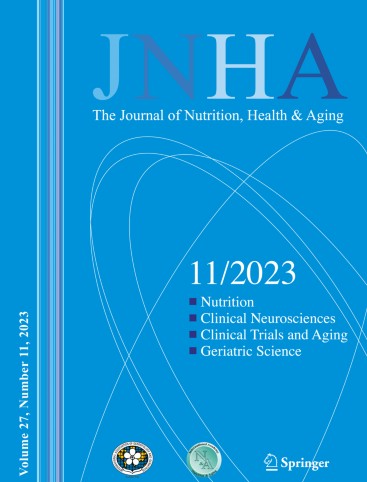骨肉疏松症比肌肉疏松症更容易导致功能性残疾:FraDySMex 队列研究的纵向分析。
IF 4
3区 医学
Q1 GERIATRICS & GERONTOLOGY
引用次数: 0
摘要
目的:衰老会导致身体成分发生重大变化,表现为肌肉质量和骨矿物质密度下降,同时脂肪量增加。肌肉疏松症的特点是力量和肌肉质量下降,而骨质疏松症则是肌肉疏松症和骨质疏松/骨质疏松症的并存。从生理学角度看,肌肉和骨骼组织之间存在着由多种途径介导的相互影响。肌肉疏松症和骨质疏松症都与功能性残疾等不良后果有关。然而,目前还缺乏纵向研究。因此,本研究旨在评估肌肉疏松症和骨质疏松症表型是否会增加社区成人纵向队列中功能性残疾的风险:本研究是对前瞻性队列 FraDySMex(墨西哥成年人虚弱、动力性和肌少症)数据的二次纵向分析:FraDySMex的研究对象是居住在墨西哥城的50岁或以上的社区成年人。2014年至2015年的数据被视为基线评估,2019年的数据为后续评估。具有完整基线和随访评估的个体均纳入分析:肌少症的诊断遵循 FNIH 标准,而骨质疏松症/骨质疏松症的分类遵循世界卫生组织指南。骨质疏松症是指同时存在肌肉疏松症和骨质疏松/骨质疏松症。功能性残疾通过劳顿日常生活活动量表(IADL)来确定。我们估算了调整后的混合效应逻辑回归模型,以评估身体成分表型对功能性残疾风险的影响:最终样本包括 320 名具有完整纵向数据的成年人。其中大部分为女性(83.4%),受教育年限为 7-12 年(48.4%)。在基线评估中,50.9%的人年龄在 50-70 岁之间。与无骨质疏松症/肌肉疏松症组相比,骨质疏松症表型与较高的功能性残疾风险相关(OR:2.17,p = 0.042)。相反,肌肉疏松症(OR:1.50,p = 0.448)和骨质疏松症/骨质疏松症(OR:1.50,p = 0.185)表型与功能性残疾无关:我们的研究强调,骨肉疏松症会显著增加功能性残疾的风险,尤其是在日常生活工具性活动(IADL)方面。这些结果强调了在各种临床环境中筛查肌肉疏松症、骨质疏松症/骨质疏松症和骨肉疏松症的重要性。早期检测和干预有望避免成人功能性残疾并减轻相关不良后果。本文章由计算机程序翻译,如有差异,请以英文原文为准。
Osteosarcopenia predicts greater risk of functional disability than sarcopenia: a longitudinal analysis of FraDySMex cohort study
Objectives
Aging involves significant changes in body composition, marked by declines in muscle mass and bone mineral density alongside an increase in fat mass. Sarcopenia is characterized by low strength and muscle mass, and osteosarcopenia is the coexistence of sarcopenia and osteopenia/osteoporosis. Physiologically, there is a crosstalk between muscle and bone tissues mediated by several pathways. Both, sarcopenia and osteosarcopenia, have been related with adverse outcomes such as functional disability. However, there is a lack of longitudinal studies. Therefore, this study aimed to assess whether sarcopenia and osteosarcopenia phenotypes increased the risk of functional disability in a longitudinal cohort of community-dwelling adults.
Design
This study constitutes a secondary longitudinal analysis of data derived from the prospective cohort FraDySMex (Frailty, Dynapenia, and Sarcopenia in Mexican adults).
Setting and participants
FraDySMex is conducted in community-dwelling adults aged 50 years or older living in Mexico City. Data from 2014 to 2015 was considered as baseline evaluation, and the 2019 wave was the follow-up evaluation. Individuals with complete baseline and follow-up evaluations were included in the analysis.
Measurements
Sarcopenia diagnosis adhered to the FNIH criteria, while osteopenia/osteoporosis classification followed WHO guidelines. Osteosarcopenia was defined as the concurrent presence of sarcopenia and osteopenia/osteoporosis. Functional disability was identified by the Lawton Instrumental Activities of Daily Living (IADL) Scale. Adjusted mixed-effects logistic regression models were estimated to evaluate the effect of body composition phenotype on the risk of functional disability.
Results
The final sample included 320 adults with complete longitudinal data. The majority of were women (83.4%) and had 7–12 years of education (48.4%). At the baseline evaluation, 50.9% aged 50–70. The osteosarcopenia phenotype was associated with a higher risk of functional disability (OR: 2.17, p = 0.042) compared with the no osteopenia/sarcopenia group. Conversely, sarcopenia (OR: 1.50, p = 0.448) and osteopenia/osteoporosis (OR: 1.50, p = 0.185) phenotypes were not associated with functional disability.
Conclusions
Our study underscores that osteosarcopenia significantly increased the risk of functional disability, particularly in terms of Instrumental Activities of Daily Living (IADL). These results emphasize the importance of screening for sarcopenia, osteopenia/osteoporosis, and osteosarcopenia across various clinical settings. Early detection and intervention hold promise for averting functional disability and mitigating associated adverse outcomes in adults.
求助全文
通过发布文献求助,成功后即可免费获取论文全文。
去求助
来源期刊
CiteScore
7.80
自引率
3.40%
发文量
136
审稿时长
4-8 weeks
期刊介绍:
There is increasing scientific and clinical interest in the interactions of nutrition and health as part of the aging process. This interest is due to the important role that nutrition plays throughout the life span. This role affects the growth and development of the body during childhood, affects the risk of acute and chronic diseases, the maintenance of physiological processes and the biological process of aging. A major aim of "The Journal of Nutrition, Health & Aging" is to contribute to the improvement of knowledge regarding the relationships between nutrition and the aging process from birth to old age.

 求助内容:
求助内容: 应助结果提醒方式:
应助结果提醒方式:


